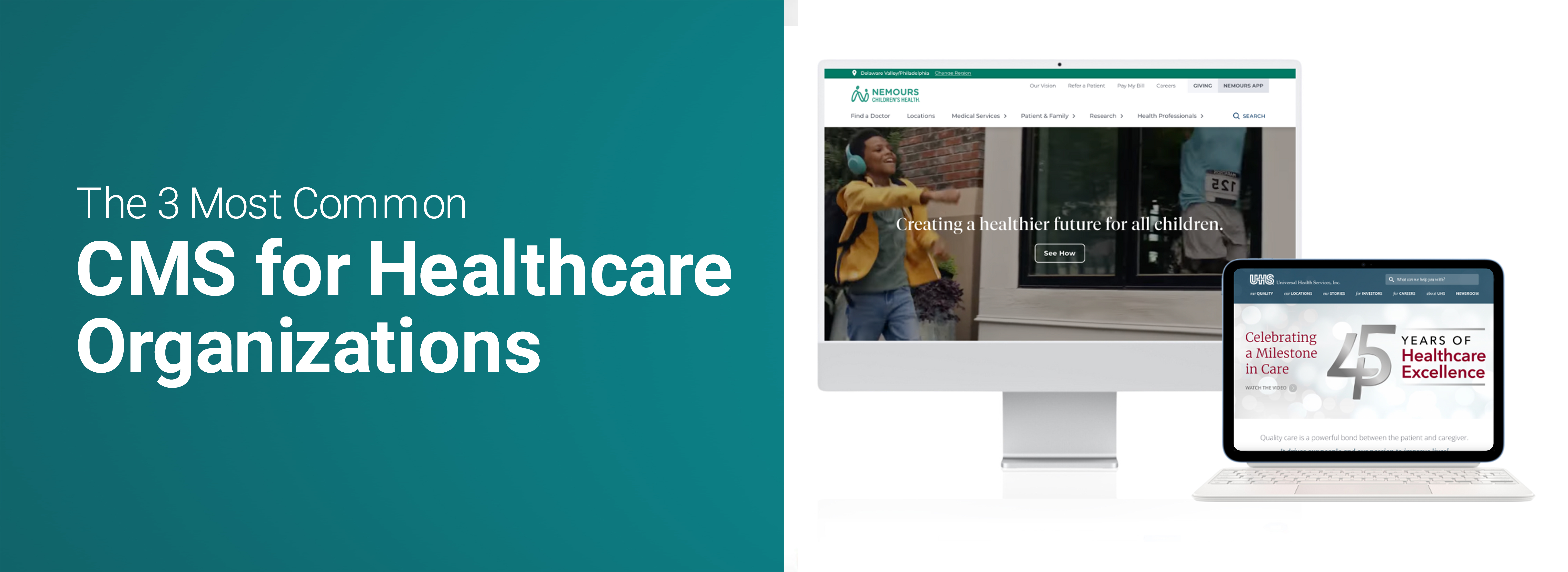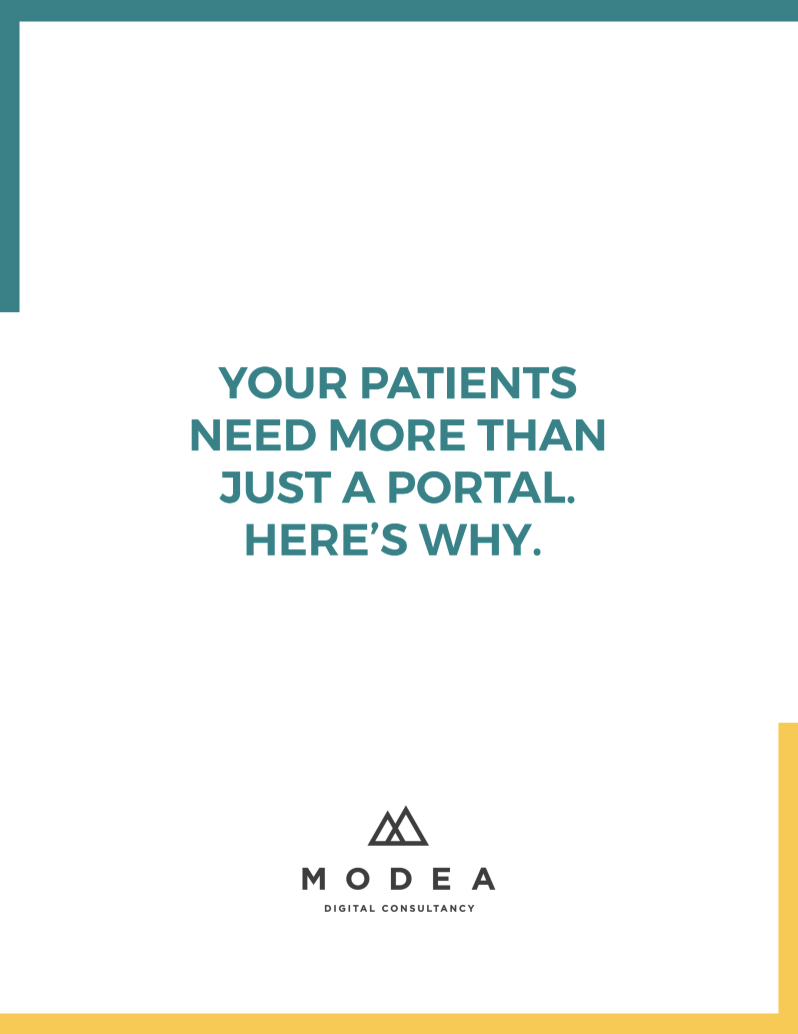
We live in a world of instant gratification that drives innovation and the adoption of new technology across healthcare. Consumers expect ease of use and zero lag time while accomplishing a goal in a few simple steps. When it works, it’s a wonderful thing, and when it doesn’t, it can ruin your day. Therefore, designing and building a beautiful and forward-thinking website is just half of the work. The other half is determining where it will all sit, digitally speaking. In this article, we will review three of the most common and widely used content management systems in healthcare.
Content management systems for healthcare
A CMS or content management system is a system that allows you to create, manage, build, and customize the digital experience for an end-user. There are a vast amount of options, however, we’ll focus on the three largest players in the healthcare space and hit a few important highlights and pitfalls of each.
Picking the right content management systems for your healthcare system is incredibly important. Information needs to be secure, fast to obtain, and hospitals need the ability to manage a CMS with scale while having the confidence that it will not crash. The consequences of a poorly chosen or implemented CMS can be catastrophic to an organization, especially one in an industry as important as healthcare. Especially since we’ve seen a dramatic increase in cyberattacks over the years, in fact, incidents rose 42% in 2020 alone.
If you’re refreshing your consumer digital experience and looking to update your current CMS or move to a new one, this should help.
Open and closed source CMS
Before we go much further, we should talk about the differences between a “closed-source” and “open-source” CMS. With open-source you have a lot more flexibility in everything from pricing to coding. Open-source is “free” for anyone to use and comes with a large community of users and developers constantly working to create and improve the platform and the plugins that come with it. This can lead to a very powerful and robust solution (when done correctly) for almost any website but can also lead to security and vulnerability issues since there are so many moving parts and constant changes.
All the above is the opposite of closed-source, which does not have an open community and coding options. With this comes increased security but also larger fees and pricing associated with implementing and managing this kind of CMS, since you’re relying heavily on the CMS creators.
There are pros and cons to each. The main takeaway is that whichever route you choose when done right, will certainly have its benefits.
So, with that, let’s get into three of the most popular content management systems for healthcare organizations out there.
WordPress CMS

We will start with the largest and most recognized CMS; WordPress. WordPress holds a whopping 43% market share of all websites on the internet. Yeah, they’re big.
WordPress is an open-sourced CMS that started as a popular blogging platform but has quickly evolved into a leader in the space. Many small, medium, and large (enterprise) sized websites are hosted on WordPress. Its flexible and customizable features are a huge plus for this CMS.
With plugins, community and developer support, and plenty of use cases and documentation to support your needs, it is usually the first choice for a developer team. It’s customizable, SEO-friendly, flexible, scalable, and offers great levels of personalization. It can be very secure, but can often take a bit more leg work.
Pros and cons of WordPress
In addition to the above, WordPress offers other benefits worthwhile mentioning:
- It is pretty easy to set up and start working with.
- Has a lower cost of ownership and setup.
- There are thousands of themes and plugins to choose from so that you find the perfect solution for your team’s needs.
- It’s relatively easy to deploy your changes and enhancements as needed.
- Is a powerful and modern editor experience when using Gutenberg.
- There are options for automatic updates to help with plugin management.
While there are plenty of reasons why WordPress is ideal to use, there are a handful of “cons” with using this platform.
- Security risks are heightened when using a large and open-source CMS. With so many features and plugins, it’s hard to always keep up with updates and minimize risk. For an enterprise site built on WordPress, this could be a full-time job.
- WordPress is typically not used on very high-traffic websites. Don’t get me wrong here, they still are to some degree, but we see this being used less and less on your enterprise-level architectures, mainly due to management and security needs.
- Finding the best modules for your implementation can be challenging and often the best ones are not free, so additional costs can add up.
Drupal CMS

Drupal is another very popular and robust option for websites of all sizes. It is another popular open-source platform that prides itself on having what they claim is the best experience of any CMS out there. It’s around 20 years old and the current newest version is Drupal 9.
*Tip: If your team is still on Drupal 7, you’ll lose community support in November 2022. Learn why you should upgrade to Drupal 9 now.*
Drupal holds a much smaller market share of websites, but that shouldn’t deter an organization from migrating over. With its robust offerings, all geared at a great web experience, it’s easy to see why Drupal is chosen for many enterprise builds. It shares the same features as WordPress as well and most CMS’ we talk about all have those by default. Drupal also has some great aftermarket support from companies, like Acquia, and they are able to add a lot to an already-solid system, making it a great choice for large, heavily-trafficked websites.
Pros and cons of Drupal
Drupal “pros:”
- Offers custom content types/capabilities that are more flexible compared to other CMS like WordPress.
- Comes with advanced security features out-of-the-box, which makes it a perfect choice for security-conscious businesses.
- Built with scalability and performance in mind. The platform is capable of handling massive traffic spikes.
- Drupal core comes with multilingual support out-of-the-box, and you do not need any additional integrations or modules for the same.
- You can have more control over access and user permissions. Its built-in access control system allows you to create custom user roles with different permissions. This feature can be highly beneficial for enterprises where access control can be a major issue.
- Many consider Drupal’s system to be more flexible than other CMS platforms. This makes the content organization much easier. You can group your content together in various configurations.
Drupal “cons:”
- Setting up with Drupal is not as easy as WordPress and you will need to rely on a Drupal developer who understands the system and complexities to get it up and running smoothly while continuing to manage it.
- Like WordPress, Drupal has plugins that will need to be updated and supported on a regular basis.
- Finding the best modules for your implementation can be challenging and often the best ones are not free, so additional costs can come with a Drupal implementation.
- With older versions of Drupal, like Drupal 7, not all of the newest and better features are available like what can be used with the latest version.
Sitecore CMS

Sitecore is a closed-source CMS that is used by enterprise-level organizations. It focuses on a solid all-around digital experience. With Sitecore you’ll likely be choosing between four main products (Sitecore Experience Commerce, Sitecore Experience Manager, Sitecore Experience Platform, and Sitecore Content Hub) to get your site up and running. Each of those products has its purpose based on your industry which means Sitecore can cater to many market segments.
Sitecore has established itself as one of the more secure platforms since it is closed-source and doesn’t offer an open door for outside developers and companies to come in and create modules, features, plugins, etc.
Pros and cons of Sitecore
Sitecore “pros:”
- As stated above, Sitecore comes out of the box with a high level of security since it is locked down pretty tightly.
- The various product offerings of Sitecore make it scalable and customizable for organizations of various types.
- Sitecore has a really strong content editing interface out of the box.
- Unlike some other open-source platforms, Sitecore comes with many sought after features by default, like personalization, analytics, segmentation, and more.
Sitecore “cons:”
- Being a custom closed-source platform, changes and enhancements will often take time and become costly.
- Speaking of costs, Sitecore is not a cheap CMS out of the gate and requires some steep licensing fees to get started.
- When managing your site and backend you will often have to rely on Sitecore’s team of developers to help, which can add time and additional costs.
Modea’s take on healthcare CMS
When looking for a well-suited CMS, the process begins with taking a deep dive to fully understand the needs of your organization and what will be required to keep your website, and customers, happy. We often assist our clients in selecting a CMS based on many factors such as:
- Size and capability of a team
- Who will be managing the system
- Any specific, unique needs
- How often the site will receive updates
- Total traffic to the site
The above and so much more are included in what we call our “Discovery Phase” and it’s a crucial part of any digital transformation. You can’t build a house without a solid foundation, and a website and digital front piece are no different here.


